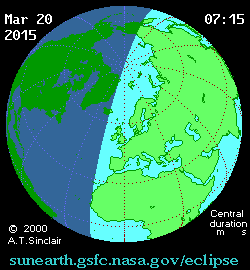¡SkyCaramba! Weekly astronomy blog for the week ending March 7, 2015
 The big event this month is a total solar eclipse. The path of totality begins in the Atlantic Ocean south of the tip of Greenland, curves around Iceland to the southeast, crosses Spitzbergen Island in the Arctic, then ends at the North Pole. Partial phases are visible as far south as northern Africa and as far east as central Russia and Mongolia. The longest totality will occur east of Iceland for 2 minutes, 48 seconds.
The big event this month is a total solar eclipse. The path of totality begins in the Atlantic Ocean south of the tip of Greenland, curves around Iceland to the southeast, crosses Spitzbergen Island in the Arctic, then ends at the North Pole. Partial phases are visible as far south as northern Africa and as far east as central Russia and Mongolia. The longest totality will occur east of Iceland for 2 minutes, 48 seconds.
The solar eclipse occurs on the same day as the March equinox which is at 22:46 UT.
In our night sky, Venus remains close above Mars at the start of the month. Uranus is above them. Venus passes 0.1° from the 8th planet on the 4th. That will be a great time to spot Uranus in a telescope. Venus continues upward. So does Mars. The red planet passes 0.3° from Uranus on the 11th.
A thin crescent moon passes Mars on the 22nd and then Venus the next night. Uranus disappears into the sunset as it heads toward solar conjunction in April. But Mars and Venus remain evening objects.
An almost full moon passes south of Jupiter on the 3rd. The big planet moves slowly closer to Cancer, but it’s slowing down and almost stationary by the end of March. Jupiter is up almost all night.
Saturn rises in the middle of the night. The moon is very close on the 12th. The ringed planet is moving slowly out of the claws of Scorpio at first. Then on the 14th, it begins retrograde motion and heads back.
See Mercury in the morning sky in the early part of this month and then in the evening sky in the last few days of this month. The messenger planet goes through aphelion on the 6th. It’s at greatest elongation the same morning!
The moon-Aldebaran occultation series continues this month on the 25th. It’s visibile in Alaska, the Yukon, and the far northern Canadian islands.
Pay attention to news about the Dawn spacecraft. It’s supposed to arrive at the asteroid Ceres around the 6th. Dates and times for some of the mission events will be determined on the fly as scientists learn more about the minor planet’s gravity and determine how the spacecraft will orbit.
¡SkyCaramba!